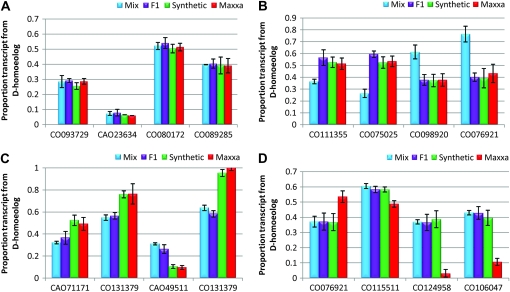Figure 4.—
Examples of tissue-specific expression alteration arising from parental divergence, genomic merger, polyploidy, and polyploidy evolution. Shown are the proportions of D-genome (y-axis) homeolog expression, including the associated standard deviation. (A) Four representative genes from petioles, which exhibit statistically equivalent ratios in all accessions, indicating little expression evolution since divergence between the A- and D-genome parents. (B) Four representative genes from leaf lamina, each showing equivalent expression among the F1 hybrid, synthetic, and Maxxa, which is not equivalent to the mix, indicating an expression change resulting from genomic merger. (C) Four representative genes from petioles (genes CAO71171, CO131379, and CAO49511) and leaf lamina (gene CO131379) showing equal genome-specific expression values in the mix and F1 hybrid, which differ from the synthetic and Maxxa, suggesting that the change occurred as a result of genome doubling. (D) Four genes in petioles showing no change among mix, F1, and synthetic, but a new expression pattern in Maxxa, indicating a change in homeolog-specific expression during the evolution (∼1–2 million years) of allopolyploid cotton.

